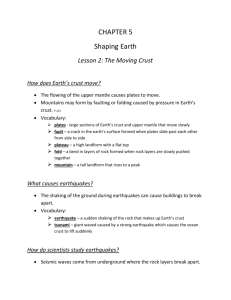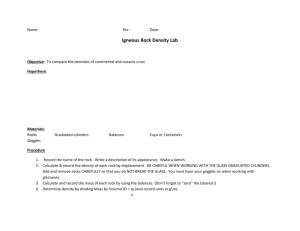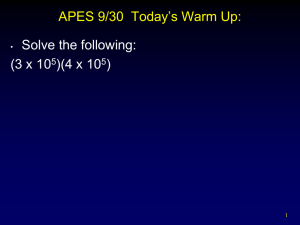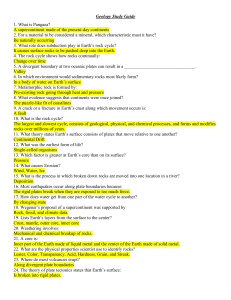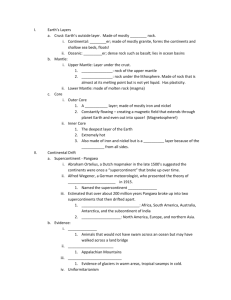Earth s Internal Zones
advertisement
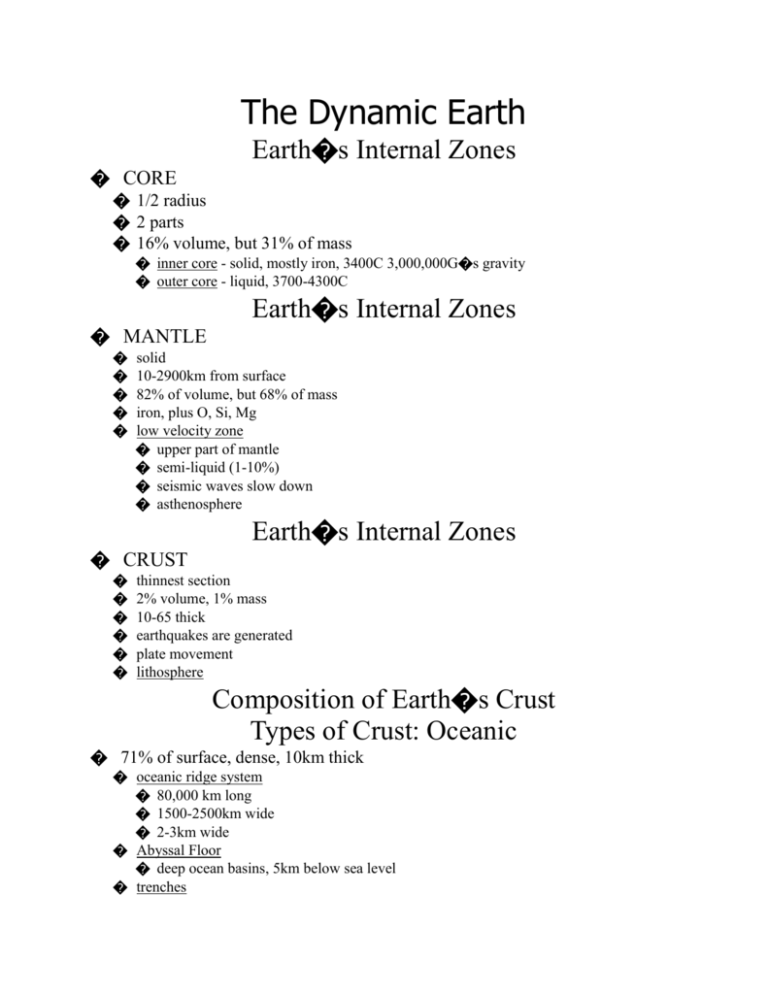
The Dynamic Earth � CORE Earth�s Internal Zones � 1/2 radius � 2 parts � 16% volume, but 31% of mass � inner core - solid, mostly iron, 3400C 3,000,000G�s gravity � outer core - liquid, 3700-4300C � MANTLE � � � � � solid 10-2900km from surface 82% of volume, but 68% of mass iron, plus O, Si, Mg low velocity zone � upper part of mantle � semi-liquid (1-10%) � seismic waves slow down � asthenosphere � CRUST � � � � � � Earth�s Internal Zones Earth�s Internal Zones thinnest section 2% volume, 1% mass 10-65 thick earthquakes are generated plate movement lithosphere Composition of Earth�s Crust Types of Crust: Oceanic � 71% of surface, dense, 10km thick � oceanic ridge system � 80,000 km long � 1500-2500km wide � 2-3km wide � Abyssal Floor � deep ocean basins, 5km below sea level � trenches � 8 km below sea level � � � � Continental Crust Higher and thicker than oceanic crust averages 35km thick lower density--> floats continental shelf- underwater portion of the continental crust Crust Plates � 100km thick (crust and mantle) - lithosphere � move over the semi-liquid asthenosphere � move at the same rate as finger nails grow (1 inch/year) Plate Techtonics � Theory that explains the apparent movement of Earth�s plates and the geological process that occur at the boundaries � The movement of the plates � is an explain the biogeography of organisms � is responsible for the earth surface features � concentration of minerals � Evidence � � � � � Plate Techtonics polar wander curves distribution of organisms distribution of ice shape of continents continued activity at boundaries Plate Boundaries Divergent Boundaries � Plates move in opposite directions � ocean spreading � creates ridge � youngest area of ocean � earthquakes and volcanoes � � � � � Convergent Boundaries Plates move toward each other often: oceanic plate is subducted under continental plate subduction zone makes a trench earthquakes and volcanoes oldest part of ocean Transform Fault � Plates move in opposite, parallel directions � San Andreas � only earthquakes External Processes: Break Down Earth�s Surface � Erosion � material is broken down, worn away, and moved � streams are primary source � also wind and gravity External Processes: Break Down Earth�s Surface � Weathering � mechanical - a large rock is broken down into smaller rocks (frost wedging) � chemical - a rock is decomposed by chemical reactions (oxidation, acid rain, hydration) External Processes: Break Down Earth�s Surface � Mass wasting � large amounts of material are carried downhill by gravity � rock slides External Processes: Break Down Earth�s Surface � Glaciers � solid, dense ice � moves downhill, carving as it goes � carries material (leaves moraines) External Processes: Break Down Earth�s Surface � Human Activities � � � � clearing land and vegetation over grazing mining off-road vehicles Rock Types: Igneous � Rocks formed by molten rock (magma) � made at plate boundaries � below surface � crystals, gem stones � eg. granite � above ground � lava, no crystals � eg. obsidian, pumice Rock Types: Sedimentary � Rocks formed from sediments, other rocks � A. small rocks carried by water � sandstone/shale � B. compaction of dead animals � limestone � C. decomposition of plants � coal � *3/4 of Earth�s surface Rock Types: Metamorphic � Rock formed when a pre-existing rock is subjected to extreme heat, chemicals and/or pressure � eg. marble, talc, graphite, slate The Rock Cycle Mineral Resources � Minerals: naturally occurring materials in or on the crust that can be extracted and converted into useful materials � *within the scale of human activities they are nonrenewable because of the slowness of the rock cycle � energy resources: coal, oil, uranium � metallic resources: iron, copper � nonmetallic: salt, clay, water, sand � Identified Categories of Mineral Resources � known location and quantity Categories of Mineral Resources � Undiscovered � believed to exist, but location unknown � Reserves Categories of Mineral Resources � identified resources that can be extracted economically Categories of Mineral Resources � Other Resources � identified, but not economical, and undiscovered � may become reserves



